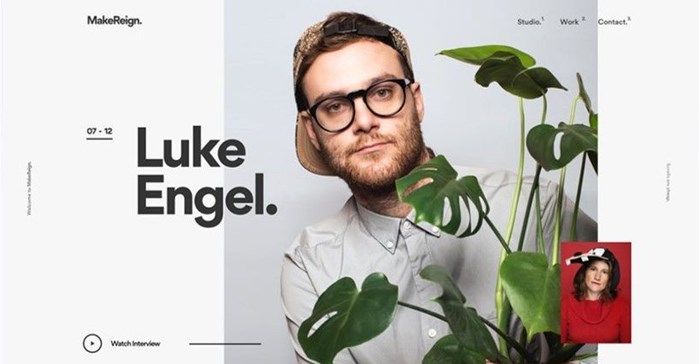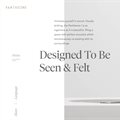
Digital Agency Showcase 2020: MakeReign

Red & Yellow selected six of South Africa's top digital agencies to share their knowledge, insights, wisdom and experiences in 30-minute slots, followed by Q&A sessions to allow attendees to drill deeper.
2020's participating agencies included:
- King James
- Ogilvy
- TBWA Hunt Lascaris
- VMLY&R
- MakeReign
- HelloFCB+
As my coverage of the event, I have selected one agency from each of the two days that stood out to me starting with MakeReign, who saw co-founder Luke Engel first up, on Day One, presenting.
Engel kicked off introducing himself and said that he tends to wear multiple hats, as is the case when working for a startup. But essentially he is responsible for the growth of their people, their brand and their partnerships.
MakeReign is a bit different from the other agencies in that they are a user interface and experience design studio. So, the majority of Engel's presentation was focused on design and design processes and how they go about thinking and approaching design.
- Advanced websites and platforms
- Mobile applications
- Creative content
Engel said that he wanted to show us projects that challenged them and share learnings that they've taken from these projects.
He said understanding content was the key part of tackling any project for them, and understanding what it is you are trying to achieve.
To achieve this, they:
- empower others with a strong, informed design (part of their mission at MakeReign), and
- collaborate with incredibly talented people because to create great work, he said, you have to work with amazing people.
What informs MakeReign's design decisions and approach?
Engel said that discovery, research and testing is very much part of their design process, and that they are trying to think of their design process in a more methodical way. This is really what informs their strategy, their design and how they implement products.
"Discovery is important because it helps us to really understand the problem or the challenge at hand." He explained that often clients would come to them and the concept and what they ask would be miles off what the solution should be.
Clients don't always have the answers and that is why they are hiring us and wanting to work with us. But it is really important to stall the process and take the time to really deep dive into the particular project. Challenging the brief and asking the questions, 'Is this the right solution?', 'Are we focusing our efforts on the right thing?', 'Is this the right time for the company to be pursuing this project?', 'Are we targetting the right people?'. So let's get into a room and let's unpack as much information as we can on the best possible solutions and let's test those solutions and take the time to understand the brand, the user and context. This is such an important part of getting the process started.Engel said that at the end of the day, you are trying to create value for a company. Companies are in the business of making money. "So you really want to focus on how you can help that business. But it's really important to bring your customers front and centre. So here, ask questions like, 'What are the issues that we are trying to solve for our users?', and 'What are the problems that they are facing?'"
Brand questions and considerations:
- Why does the business exist?
- What is its purpose?
- What are the objectives and challenges?
- What does success look like?
- How can we as designers help you get there?
The bigger picture
Engel said that they bring user research and testing into their design process to ensure they solve real problems that actually matter to their users. They question what it is that they are trying to build and seek to understand how their users are behaving, taking this into account during product development.
User research can be applied at various stages of a product lifecycle, he said. From an idea to the implementation of a product, different research methods can answer different research questions:
- Understanding users and context: what to build?
- Co-creating solutions: how to build it?
- Test and learn: is that solution right?
"It's really important that you talk to the people you are designing for and try and eliminate your own biases during the process. What matters to your business doesn't necessarily matter to your users, and sometimes you're just so close to the work, it is really difficult to see the users perspective.
"You also have to take a look at the greater scheme of things. What is happening in the industry? What are our competitors doing? What are the opportunities that have presented themselves? They then bring all of these elements into co-creating solutions. Finding out what is the best way to build this? And you are still sort of involving people in that process. Whether it is through participatory design or through card sorting techniques. You start to formulate the best strategies to deliver on the solution, and that is still driven by the users and the people using your products.
"Once we have a solution, we validate that and we test the solution, so we continue to iterate based on learning. We are still asking questions deep into the process of delivering product to people. Asking, is this the right solution? So we are still challenging our thinking and we're still challenging what we've actually produced. We are also continually learning and recovering new insights and improving throughout the process."
Data matters but what you do with it matters even more
"I think there is a lot of insight to be learnt. There is such a big focus on data - gathering data and gathering insights. But I think you can have all the data in the world but it really matters what you do with that data."
"For me, execution is just as important as ideas. This is where you as a designer or as a design team bring your craft and your intuition to the process and really start thinking how do we take this project forward. From the data that we got on hand to move it forward," he said.
"And you do that by exploring different solutions. In exploring different solutions based on the data, you proving and iterating based on more data and continuing to do that and questioning things as you go along. This ultimately leads to the right solution for the right people and the right context.
"That's our job - to figure out, are we speaking to the right people, is it the right context and have we found the right solution.
"That's how our design process informs in order to create these meaningful experiences."
Flash case study
The Flash project was a key project that stood out from the case studies he showed us, which included Pineapple Insurance and Woolworths.
Engel took us through some of the business challenges and some of the user insights they uncovered during their design process, how that shaped their approach and how they delivered an informed design solution.
The project was for the Flash mobile app and they got to go into the field and test it with users in the townships.
Who they are
Flash is an SA-based fintech company that enables (informal) retailers to sell virtual products, such as airtime, data and electricity. By providing a digital divide that prints tickets, Flash enables millions of safe transactions daily.
They really empower traders in informal communities. This is what Engel tried to get at when he spoke about meaningful experiences. "We are really trying to create an easy-to-use and understand the platform, so particularly interesting when you have to ensure that certain elements of the app can be understood by people, even by people who can't necessarily read."
Competitor analysis
They had a product already, but as their userbase increased and as the app evolved, features were being added fast and really continuously, so they needed to look at what had been created and the usability, and really align its needs to the needs of the target market.
"We really needed to listen to their customers to find out what those needs were. So it took some time to understand the users and the context. In terms of context, we started looking at competitor analysis. We researched two of their main competitors in the field and looked at their features and their functionality, their navigation type patterns, to really understand what the benchmark in the marketplace is.
Testing assumptions
Engel continued and said, "We really wanted to get it into the hands of customers as soon as possible. So, to really test our assumptions and bring people front and centre, we went into the field and did multiple rounds of testing, which was really interesting - meeting users in their own context, where they're using the products.
"In reality, most people spend their time battling with imperfect devices, slow internet speeds and interacting with products while simultaneously having to attend to other things. So, it was really important to meet the customer where they are, in order to gain that insight into how they really use the product." Read more here.
Final thoughts
- Designers need to understand the business. Understanding the business goals, objectives and problems is key to finding the right solutions.
- We got to continue learning, question everything. Master the art of asking questions and be inquisitive. It really teaches you about how people think about things and how they use things.
- Bring your customer front and centre from early on in the process.
- Test and validate your assumptions. It's okay to make assumptions but you really need to test it and prove it to be true.
- They are not always right but sometimes they are.
- What you do with data is more important than the data itself.
- Our job is to find the right solution for the right people in the right context.
- Always be learning and proving and iterating.
- It's all about creating meaningful experiences.
Visit the MakeReign press office for news and updates, click here for more news and write-ups on past projects and you can also visit their website to get in touch.
About Juanita Pienaar
View my profile and articles...

